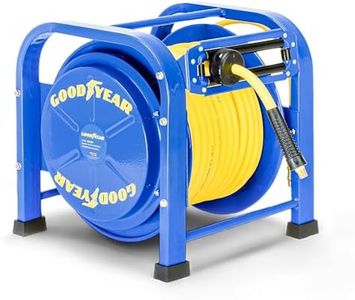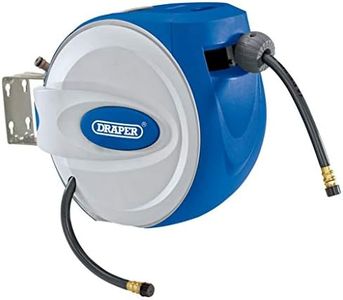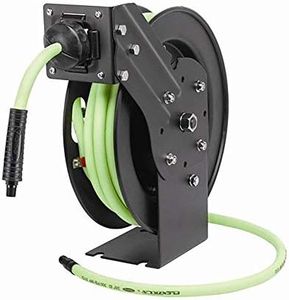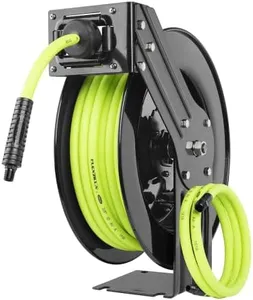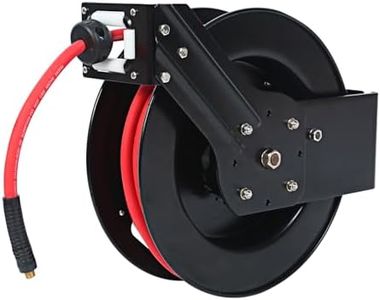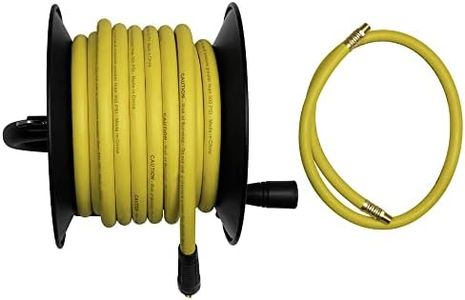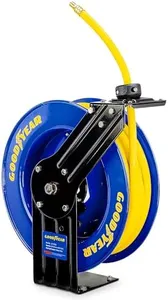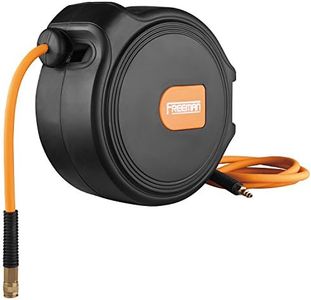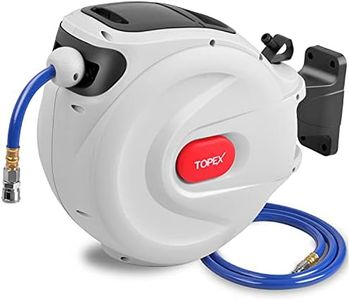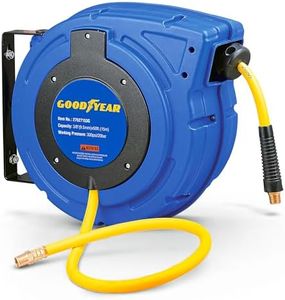We Use CookiesWe use cookies to enhance the security, performance,
functionality and for analytical and promotional activities. By continuing to browse this site you
are agreeing to our privacy policy
10 Best Retractable Air Hoses
From leading brands and best sellers available on the web.Buying Guide for the Best Retractable Air Hoses
Choosing the right retractable air hose is essential for anyone looking to make their work with air tools more efficient and tidy. A quality retractable system helps keep your workspace clutter-free, reduces tripping hazards, and extends the life of your hose by protecting it from unnecessary wear. To find the best match for your needs, it's important to look at a few key specifications and understand how they relate to your intended use.Hose LengthHose length is the total distance the hose can extend from the reel. It's important because it determines how far you can move away from your air source to use your tools. Short hoses (around 20-30 feet) are suitable for small garages or workshops where you rarely move far from the compressor. Medium lengths (30-50 feet) are versatile for most home users, while longer hoses (50 feet and above) are best for large workspaces or outdoor projects. When choosing, think about the size of your workspace and the maximum distance you'll need to reach with your tools.
Hose DiameterThe diameter of an air hose impacts the air flow delivered to your tools. Common diameters are 1/4”, 3/8”, and 1/2”. Smaller diameters (1/4”) are light and easy to handle but might limit the air supply for heavy-duty tools. Medium diameters (3/8”) strike a balance between flexibility and airflow, suitable for most general tasks. Larger diameters (1/2”) deliver the most airflow and are chosen for tools that require a lot of air, like impact wrenches or sanders, but they are heavier and less flexible. Consider what tools you’ll use and their air requirements—lighter, frequent jobs need less diameter, while bigger tools benefit from more air.
Reel ConstructionThe reel construction refers to the materials and build quality of the part that holds and retracts the hose. Reels can be made from plastic, steel, or aluminum. Plastic reels are lightweight and resist corrosion but are best for light-duty or occasional use. Metal reels (steel or aluminum) are more durable and suitable for regular or heavy-duty use, especially in a professional or outdoor environment. Think about how often and in what kind of setting you’ll use the hose—frequent use in tough conditions calls for a sturdier reel.
Hose MaterialAir hoses are typically made from materials like rubber, PVC, polyurethane, or hybrid blends. Rubber hoses are very flexible and durable, even in cold conditions, but are a bit heavy. PVC hoses are lighter and less expensive but tend to be stiff, especially in colder weather. Polyurethane hoses are lightweight, flexible, and resist kinking, making them great for frequent use. Hybrid hoses combine features for flexibility and durability. Your choice should depend on whether you value easy handling and flexibility or maximum durability and width of temperature range.
Retracting MechanismThe retracting mechanism is the system that pulls the hose back into the reel. There are spring-operated, motorized, and manual wind models. Spring-operated is most common for home and medium use, providing automatic retraction—just a tug and the hose winds itself in. Motorized is rare but can be useful for large, heavy-duty setups. Manual wind types require you to crank it back in and are more basic. If you want convenience and speed, the automatic spring mechanism is best for most users, while manual might suffice for limited, infrequent use.
Mounting OptionsSome retractable air hose reels are designed to be mounted on a wall, ceiling, or even portable. Wall and ceiling mounts keep the hose out of the way and save floor space, ideal for workshops or garages with permanent setups. Portable models are better if you need to move the reel between locations. Consider your workspace arrangement—if you want a permanent fixture, wall or ceiling mount is best; for flexibility and movement, look for portable reels.
Maximum Working PressureThis value tells you the highest air pressure the hose can safely handle. Lighter hoses might be rated for up to 150 PSI, while heavy-duty hoses can handle pressures of 300 PSI or more. It's important to match the hose to your air compressor and the requirements of your tools. If your compressor or air tools operate at high pressure, make sure your hose can handle it with some room to spare for safety.
